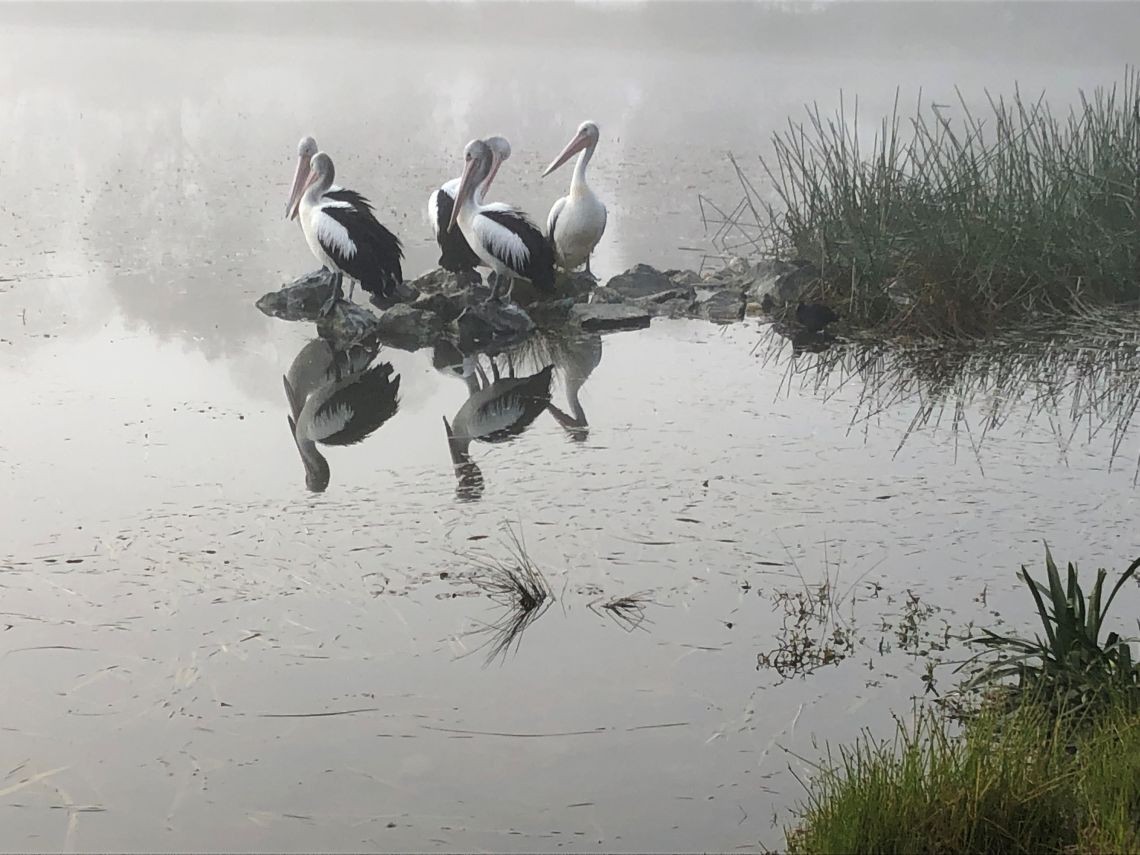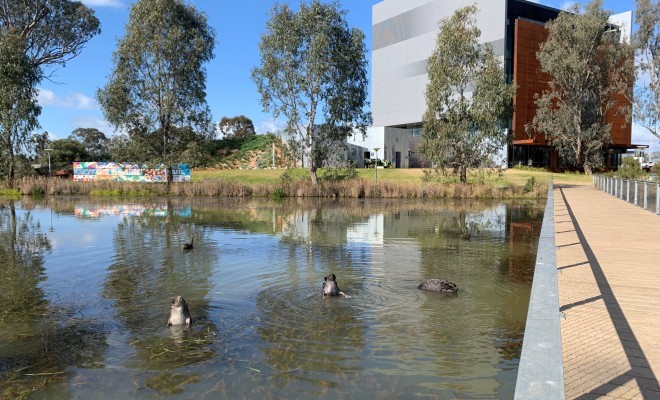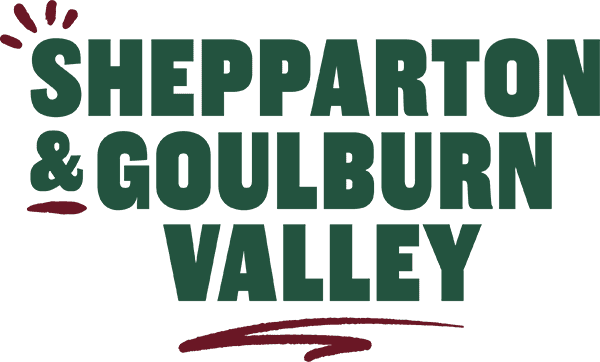Top Bird Watching Spots
Victoria Park Lake
Wyndham Street, Shepparton
Victoria Park Lake is a serene and scenic area, renowned for its bird watching opportunities, along with walking, cycling, picnicking, fishing and outdoor games. Bird enthusiasts will find the area especially appealing as it attracts a diverse range of bird species, including pelicans, ibis, ducks, fairy wrens, black swans and more. Over the years, the lake has been a central hub of community life. The precinct features walking tracks, bike paths, a skate park, table tennis, playgrounds and boating facilities.
If you’re going for a walk around Victoria Park Lake, download a copy of RiverConnect’s Bird Bingo and see how many species you can find. Alternatively, drop into the Visitor Centre, located at 530 Wyndham Street, to pick up a printed copy.
Further Reading: Victoria Park Lake Guide
Further Reading: Cycle in Greater Shepparton Guide
Further Reading: Walk in Greater Shepparton
Further Reading: Goulburn & Broken River Access Map - Shepparton
Lower Goulburn National Park (Reedy Swamp)
Wanganui Road, Shepparton
The Lower Goulburn National Park is the area stretching along the Goulburn River between Shepparton and Echuca was declared a National Park in 2008. The park is lined with River Red Gum (Eucalyptus camaldulensis) and forms an important wildlife corridor linking the mountains of the Great Dividing Range to the Murray River. Reedy Swamp provides an ideal location for bird spotting, particularly waterbirds, including the Glossy Ibis and the Royal Spoonbill.
Australian Botanic Gardens Shepparton
Botanic Gardens Avenue, Kialla
Located a four kilometre drive (or a two kilometre walk/cycle) from Victoria Park Lake, the Australian Botanic Gardens Shepparton is not only beautiful to see, but teeming with birdlife. The native flora planted throughout the garden attracts all kinds of native Australian birds. Walk the paths of the Billabong and River Walks to see Kookaburras, Kingfishers, Honeyeaters, Rosellas and more. In the Native Forest Walk you’ll find Fairy-wrens, Robins, Wattlebirds and other colourful species. Wander around the Wetlands to see Herons, Egrets, Spoonbills, and other waterbirds.
Further Reaching: Birds of the Botanic Gardens Shepparton Guide
Gemmill Swamp Wildlife Reserve
Echuca Road, Mooroopna
Gemmill Swamp Wildlife Reserve covers an area of approximately 170 hectares of Goulburn River floodplain forest and wetland between the urban centres of Mooroopna and Shepparton. The Reserve includes Gemmill Swamp, a high conservation value wetland of State significance, and a surrounding area of relatively natural river red gum forest. Gemmill Swamp Wildlife Reserve is significant in a statewide context because it provides habitat for some of Victoria’s rare and vulnerable mammals, birds and reptiles, including squirrel glider, turquoise parrots and superb parrots.
Cussen Park
Tatura-Undera Road, Tatura
Cussen Park is a bushland-style park spanning 33 hectares of wetlands, woodlands, and open spaces on the northern outskirts of Tatura. Surrounded by industrial, residential, and irrigated farmland, Cussen Park features constructed wetlands, bird hides, observation decks, and well-developed paths and signage. These amenities allow visitors to closely observe numerous bird species that might otherwise go unnoticed. Additionally, the park offers the Hear & There Sound Walk, an innovative audio tour experience supported by interpretative signage that guides you through the wetland ecosystem. Cussen Park is the home to a diverse range of bird species including cormorants, ducks, herons, pelicans, kookaburras, cockatoos, galahs, parrots, rosellas, fairy wrens, honey-eaters, willow wagtails, magpies, and many others.
Further Reading: Birds of Cussen Park Guide
Further Reading: History and Further Information | Cussen Park - Tatura, Victoria
Doctors Swamp Wildlife Reserve
Bendigo-Murchison Road, Murchison
Doctors Swamp, a 200- hectare red gum swamp near Murchison, is one of the most pristine red gum swamps in Victoria. This wetland supports a diverse range of native wetland plants and provides essential habitat for water-birds. The area is teeming with birdlife, hosting over 60 species, and is conveniently located along the Murchison Rail Trail.
Essential Bird Watching Tips
Here are some tried-and-tested tips from the Victorian National Parks Association for finding birds, and what to do when you’ve spotted one!
Spotting Birds
If a bird pops by on your daily comings and goings, stop and watch it. Take time to admire it. Listen – Sometimes birdwatching is really more about bird listening! If you hear a bird calling, see if you can spot it. If you notice bird-like movement, e.g. a shadow overhead or fluttering in the trees, see if you can find it. You can look for birds anywhere from your backyard to forests and the coast. Your best bet is looking where their food and water is. Areas such as wetlands and open waterways are good places to start. When actively trying to spot birds, keep still and quiet. Don’t be afraid of binoculars. While you don’t have to use binoculars to watch birds it will open up a new world. You will be able to get a better view of birds in the distance.
Noticing the Features of the Bird
Features which will aid in their identification include:
- Location – where in the world, what type of habitat and whereabouts in the habitat. e.g. the bird might be in the Greater Shepparton area, in a forest, on the ground.
- Shape – body, beak, legs, wings, in flight.
- Size – compare with a nearby known bird or object for relative size.
- Colours and patterns.
- Sound of their call.
- Behaviour – what are they doing? How are they flying/moving? Are they interacting with others e.g. in a noisy flock or solitary and quiet?
Identifying Birds
Once we have taken time to notice and admire the features of a bird, we can use this information to identify them. There are many books and apps with details on Australia’s birds. These resources will guide you through identifying your bird. They include information on the geographic area where the bird is known to live as well as the bird’s features. Often birdwatching is more about bird listening. You will sometimes hear a bird but not see it.
Where to Watch Birds
You can birdwatch from anywhere! Birds live in our cities, suburbs, the countryside and at sea. They occupy almost every habitat on the planet. You can find birds in your garden, local street and park. Start by getting to know what’s around in the places you visit regularly. You can also check your birding apps on your phone for suggested birding sites. eBird has interactive maps and lists that let you see which birds have been seen recently in your area or in places you plan to visit.
Best Times of the Day for Birdwatching
The best time of day for bird observation is early morning.
Further Reading: Birdwatching for beginners
Further Reading: Greater Shepparton, Victoria, Australia - eBird
Bird Watching Events & Community
BirdLife Murray-Goulburn is a small friendly group of birdwatchers who flock once a month for a day of birdwatching. They are centred in Shepparton, Victoria.
Birdlife Murray-Goulburn’s territory covers central and north-eastern Victoria. This is a large and diverse area, including the Goulburn River catchment, the Strathbogie Plateau, parts of Victoria’s High Country, Mt. Samaria, the Warby Ranges and points in between. Some of our local birds include Turquoise Parrot, Grey-crowned Babbler, Spotted Quail-thrush, Diamond Firetail and many more species.
They hold birding outings monthly (except January) and normally go on an annual extended camp, which can be held in other parts of Victoria. They also do quarterly surveys at Winton Wetlands, and regular surveys at the Australian Botanic Gardens (Shepparton) as well as the Violet Town and Euroa areas. Several members participate in Birds on Farms surveys.
They also have an active Facebook group where interesting bird sightings can be reported. Their contact details can also be found on their Facebook page.
Combining Bird Watching with Other Activities
Kaiela or the Goulburn River is one of 18 Heritage Rivers in Victoria. The Broken River flows into the Goulburn in the heart of Shepparton. Their floodplains and swamps between Shepparton and Mooroopna have great cultural significance and are integral to maintaining the rivers’ health and supporting our community.
Yahna Gurtji Shared Path
The Yahna Gurtji Shared Path network encompasses over 40km of sealed paths that wind along the Goulburn and Broken Rivers in Shepparton and Mooroopna. Yahna Gurtji means ‘Come walk with me friend’ and the pathways take you to some of the most beautiful locations in Greater Shepparton. Not only can you take in our amazing rivers, but the pathways wind through the Shepparton Regional Park between Shepparton and Mooroopna and encompass the history of the local Yorta Yorta people at The Flats. Playgrounds, barbecue facilities, fishing, kayaking and canoeing access, drink and exercise stations and even a bike repair station are all along safe pathways for the whole family to enjoy, be it riding, running or walking. Bird watching can be incorporated into a walking or cycling trip, making for a family friendly outing. There are also local cafes and restaurants close to Victoria Park Lake e.g. Elsewhere at SAM, Park Lake Restaurant.
KidsTown
KidsTown is an Adventure Playground designed to entertain, stimulate and educate children in a bushland setting. Why not combine play and bird watching? More information and opening hours visit their website.
The Flats
The Flats was home to many Aboriginal families after the Cummeragunja Walk Off in 1939, The Flats is a culturally significant area within the Shepparton Regional Park. Stories are shared through interpretive signage on the unsealed path, accessible by foot from the Shared Path along the midland highway, or via the car park on McLennan Street. Why not combine history and bird watching?
Other Greater Shepparton Walking/Cycling/Bird watching Destinations
Dookie Rail Trail
The Dookie Rail Trail was the first in Greater Shepparton. A perfect opportunity to experience the charismatic township of Dookie and view the differing landscapes of Greater Shepparton.
Start / Finish: Dookie CWA Gardens, Mary Street, Dookie.
Distance: 9.3km return.
Surface: Sealed gravel path, one small area is unsealed but in good condition.
Topography: Generally flat with small undulations.
Set at the base of Mt Saddleback, to the south you can see Mt Major, Gentle Annie hill to the south east and to the west you will see St Mary’s Church, built in 1898. The church also features stained glass windows dating from 1911. During Summer the countryside is scattered with hundreds of rolls of hay, with Autumn giving you the spectacular sights of red volcanic sands with patches of green growth for which Dookie is renowned. The area in Spring is ablaze with golden canola and green with legumes and grape vines. Flora and fauna along the path include echidnas, blue tongue lizards, kangaroos and even wedge tailed eagles. If you are lucky enough, you may even spot the local resident “Willy the Wombat '' whose den is under the road drain at the third intersection.
Hazards: Take care when crossing all roads. Be aware of snakes during the warmer months.
Enjoy a coffee or cake from the Dookie Emporium and discover amazing antiques and bric-a-brac for sale. There are no toilet or water facilities offered on the rail trail but these are available at the Dookie CWA Gardens or the Emporium during opening hours.
Murchison Rail Trail
The new Murchison Rail Trail has been constructed on a railway that was built in the 1880’s to connect Murchison and Rushworth with Melbourne. The railway line was closed in 1987.
Start / Finish: Junction of Gregory Road and Bendigo–Murchison Road, Murchison.
Distance: 7.7km one way 15.4km return. When: Dryer conditions.
Surface: Unsealed, fine gravel.
Topography: Flat.
Features: Doctor’s Swamp Wildlife Reserve, a significant River Red gum wetland is abundant with birdlife. Irrigation channels linked to Waranga Basin. Restored timber bridge crossing Stuart Murray Channel.
Murchison township, this river bank garden town is home to historic buildings and is the site where the Murchison Meteorite fell on 28 September 1969.
Hazards: The unsealed trail can be slippery when wet so care is required during wet conditions. Beware of snakes during the warmer months.
Ride notes: The trail will be extended in the future with further stages planned. Toilet and water facilities are not available along the trail, these are available in Murchison township. Parking is available on Gregory’s Road.
Further Reading:Goulburn and Broken River Access Shepparton & Mooroopna
Further Reading: Cycle in Greater Shepparton
Conservation & Respect for Nature
Wildlife Victoria states that ‘the best way to protect wildlife is to protect the places where they live. They say that ‘protecting habitat also protects entire communities of animals and plants. Wildlife must have places to find food, shelter and raise their young. Parks, reserves and other open spaces benefit wildlife by providing habitat, while also providing us with great places to visit and enjoy.’
Further reading: Protecting wildlife
Ethical Bird Watching Guidelines from BirdLife Australia
- Do not stress birds or expose them to danger
- Do not use spotlights, call playback or drones
- Avoid handling birds except when absolutely necessary (e.g. an injured bird in danger)
- Help bird conservation by recording observations and standardised surveys in Birdata
- When providing food or water for native birds, do it safely and appropriately for the birds
- Care for the birds’ habitat
- Respect the law and the rights of others’
Further Reading: Ethical Birdwatching Guidelines - BirdLife Australia.
Get out and explore Shepparton and Goulburn Valley’s bird watching spots. Share your bird watching experiences and photos on social media and don’t forget to tag @sheppandgv on Facebook and Instagram and use #SheppandGV.




